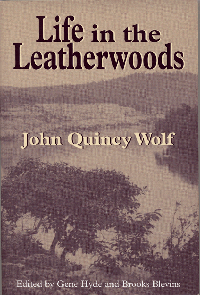John Quincy Wolf, Sr. was born in 1864 across the White River from Calico Rock, Arkansas,
on a farm nestled against the Leatherwood foothills, a rugged area in the White River country
named for the distinctive leatherwood shrub (Dirca palustris) that hugged the
stream banks, wooded slopes, and rocky bluffs of the region.
 After his parents died, he was
raised by his aunt and uncle, William T. and Eliza Wolf Swan. His memories of his youth
form the narrative we now know as Life in the Leatherwoods.
After his parents died, he was
raised by his aunt and uncle, William T. and Eliza Wolf Swan. His memories of his youth
form the narrative we now know as Life in the Leatherwoods.
After a brief stint working on a White River steamboat, as described in the last chapter of Life in the Leatherwoods, Wolf settled in Batesville, Arkansas, a busy center of commerce, where he quickly established himself as an important member of the community. His interests led to banking, and he helped organize the Arkansas Banker’s Association, serving as its president in 1907.
He married Adele Crouch in 1889 and built a home in Batesville. After his bank failed in the Great Depression, Wolf began to write articles for various newspapers in Batesville, Little Rock, and Baxter county. He was an avid observer of the human condition, blessed with broadly catholic tastes, a gift for narrative, and strong opinions on a number of topics, traits which easily found their way into print.
When John Q. Wolf died in 1949, he left behind scores of stories, articles, and fragments. In the 1930’s, while his son, John Quincy Wolf, Jr., was working on his doctorate in English at Johns Hopkins, he began to correspond with H. L. Mencken, sometimes correcting outlandish claims that Mencken made about Wolf’s beloved Arkansas. When Mencken read John Q. Wolf’s narratives of his youthful days in the Ozarks, he encouraged the Wolfs to collect them and publish them as a book.
Quincy Wolf worked on his father’s stories for many years and compiled the mass of writings into a cohesive narrative. When he died in March, 1971, he left behind a box filled with edited, corrected, and neatly typed individual chapters of his father’s stories. Soon after his death, his widow, Bess Millen Wolf, completed editing the papers and prepared them for publication. After reflecting on the various titles she and Quincy Wolf had discussed, she finally decided to call the book Life in the Leatherwoods. It has now been published by three different publishers, the most recent edition being the University of Arkansas Press edition (2000). It is available through the University of Arkansas Press or online booksellers.
 Life in the Leatherwoods, with its fine prose and sly wit, is an enjoyable portrait of
life in the late nineteenth century Ozark region.
As such, it is a valuable resource for
Ozark scholars, southern historians, folklorists, and general readers. As one of only a
handful of memoirs of nineteenth century Ozark life, it serves as a window into the social,
family, and agricultural life of a largely misunderstood and stereotyped people.
Life in the Leatherwoods, with its fine prose and sly wit, is an enjoyable portrait of
life in the late nineteenth century Ozark region.
As such, it is a valuable resource for
Ozark scholars, southern historians, folklorists, and general readers. As one of only a
handful of memoirs of nineteenth century Ozark life, it serves as a window into the social,
family, and agricultural life of a largely misunderstood and stereotyped people.
Wolf’s descriptions of life on a hillside farm in a remote, rural community in White River country serve as one of the best primary sources for nineteenth-century Ozark studies. Wolf described a post-Civil War region that had been settled by white American pioneers for more than fifty years but that, due to isolation and rugged terrain, retained elements of frontier existence. More tellingly, however, Wolf’s recollections tend to temper long held stereotypes and assumptions about the backwardness and uniqueness of the Ozark region. The log rollings, house raisings, spelling bees, and country dances of the Leatherwoods were common occurrences in most rural American communities of the day.
Wolf’s recollections of his family’s agricultural activities may require scholars to reevaluate the traditional view of the Ozark farmer. Like most Ozark agriculturists Wolf’s uncle and aunt, William and Eliza Swan, utilized a diverse array of crops and livestock to survive. They rotated crops of oats, millet, corn, cow peas, cotton, tobacco, and wheat, maintained an impressive orchard, and raised a variety of vegetables for home use. In addition, they maintained work stock, cattle, hogs, and poultry. Though the Swan farmstead would certainly have been isolated and remote even by late nineteenth century, rural American standards, the Swans were not completely isolated from the market economy. They sold cotton and other goods, and made a modest income as part of the market economy. With this cash they purchased items they could not produce on the farm: coffee, salt, spices, sugar, clothing materials and items, horseshoes, nails, and farm equipment. They also occasionally made a larger purchase, such as a wrought iron cook stove and a clock.
The steamboats on White River, as documented by Wolf, alleviated much of the region’s natural isolation by providing transportation to downstream markets for Ozark agricultural products and by bringing manufactured goods from St. Louis and New Orleans into the upper White River country. The boats also brought exotic visitors -- such as the black deck hands recalled by Wolf -- as well as news of the world outside the hills. Consequently, though John Quincy Wolf’s Leatherwoods community seems unusually remote and isolated today, in the late nineteenth century its proximity to White River, the Ozark region’s lifeline, rendered it relatively less isolated than other less rugged Ozark areas outside the White River country.
Life in the Leatherwoods provides the most complete, first-hand view of Ozark life
in the two decades following the Civil War. Yet Wolf’s work was foremost a labor of love,
a memoir of a childhood few even in the Depression era could have related to, a
benediction for a community that existed so vibrantly and humorously only in the mind of
John Quincy Wolf. The semi-frontier, rural communities of the Leatherwoods,
of the White River country, and of the entire American countryside have long since
disappeared. We are fortunate indeed to be able to greet the twenty-first century by
once again presenting such a delightful and intriguing tale of an Ozark boyhood in the
nineteenth.

Text edited from the introduction to Arkansas Press edition of Life in the
Leatherwoods. Used by permission of the editors.
The photos of J. Q. Wolf and Calico Rock are from the Wolf Collection at Lyon College.

